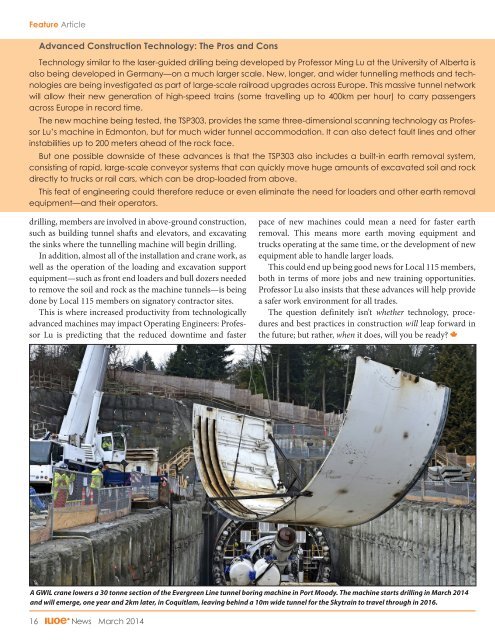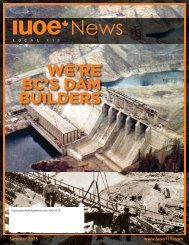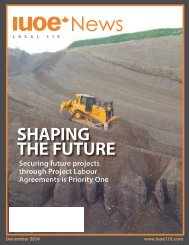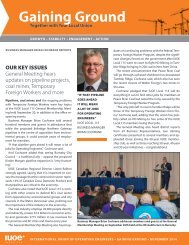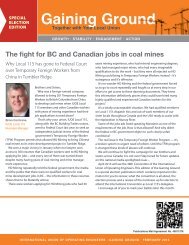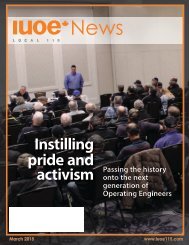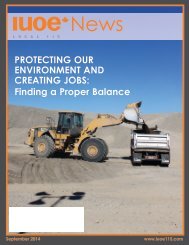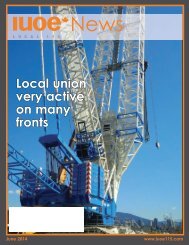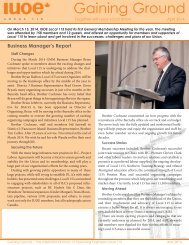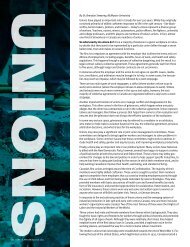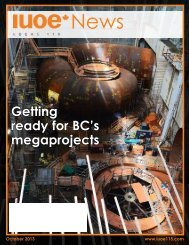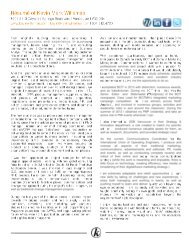IUOE News Spring 2014
The March 2014 edition of the OE News, the official quarterly publication of the International Union of Operating Engineers Local 115
The March 2014 edition of the OE News, the official quarterly publication of the International Union of Operating Engineers Local 115
You also want an ePaper? Increase the reach of your titles
YUMPU automatically turns print PDFs into web optimized ePapers that Google loves.
Feature Article<br />
Advanced Construction Technology: The Pros and Cons<br />
Technology similar to the laser-guided drilling being developed by Professor Ming Lu at the University of Alberta is<br />
also being developed in Germany—on a much larger scale. New, longer, and wider tunnelling methods and technologies<br />
are being investigated as part of large-scale railroad upgrades across Europe. This massive tunnel network<br />
will allow their new generation of high-speed trains (some travelling up to 400km per hour) to carry passengers<br />
across Europe in record time.<br />
The new machine being tested, the TSP303, provides the same three-dimensional scanning technology as Professor<br />
Lu’s machine in Edmonton, but for much wider tunnel accommodation. It can also detect fault lines and other<br />
instabilities up to 200 meters ahead of the rock face.<br />
But one possible downside of these advances is that the TSP303 also includes a built-in earth removal system,<br />
consisting of rapid, large-scale conveyor systems that can quickly move huge amounts of excavated soil and rock<br />
directly to trucks or rail cars, which can be drop-loaded from above.<br />
This feat of engineering could therefore reduce or even eliminate the need for loaders and other earth removal<br />
equipment—and their operators.<br />
drilling, members are involved in above-ground construction,<br />
such as building tunnel shafts and elevators, and excavating<br />
the sinks where the tunnelling machine will begin drilling.<br />
In addition, almost all of the installation and crane work, as<br />
well as the operation of the loading and excavation support<br />
equipment—such as front end loaders and bull dozers needed<br />
to remove the soil and rock as the machine tunnels—is being<br />
done by Local 115 members on signatory contractor sites.<br />
This is where increased productivity from technologically<br />
advanced machines may impact Operating Engineers: Professor<br />
Lu is predicting that the reduced downtime and faster<br />
pace of new machines could mean a need for faster earth<br />
removal. This means more earth moving equipment and<br />
trucks operating at the same time, or the development of new<br />
equipment able to handle larger loads.<br />
This could end up being good news for Local 115 members,<br />
both in terms of more jobs and new training opportunities.<br />
Professor Lu also insists that these advances will help provide<br />
a safer work environment for all trades.<br />
The question definitely isn’t whether technology, procedures<br />
and best practices in construction will leap forward in<br />
the future; but rather, when it does, will you be ready?<br />
A GWIL crane lowers a 30 tonne section of the Evergreen Line tunnel boring machine in Port Moody. The machine starts drilling in March <strong>2014</strong><br />
and will emerge, one year and 2km later, in Coquitlam, leaving behind a 10m wide tunnel for the Skytrain to travel through in 2016.<br />
16 <strong>News</strong> March <strong>2014</strong>


